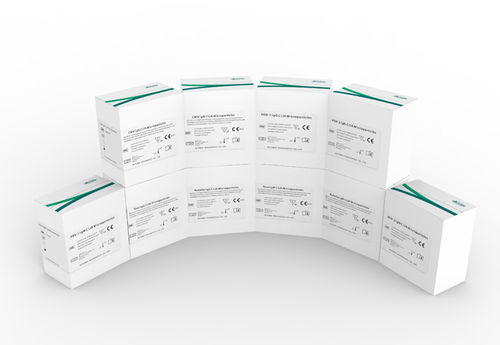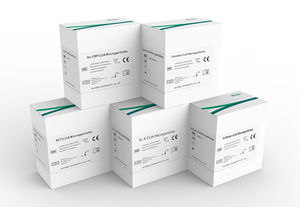
- Laboratory
- Laboratory medicine
- Rubella test kit
- Autobio Diagnostics
TORCH infection test kit CMK0102herpesrubellapregnancy
Add to favorites
Compare this product
Characteristics
- Applications
- herpes, rubella, for TORCH infections
- Application field
- pregnancy
- Tested parameter
- immunoglobulin, IgG, IgM
- Micro-organism
- HSV, Toxoplasma gondii
- Sample type
- clinical, serum, plasma
- Sample volume
0.01 ml, 0.03 ml
(0.00034 US fl oz, 0.00101 US fl oz)
Description
TORCH infections are a group of congenital infection and perinatal infection caused by pathogens, toxoplasma gondii (TOX), other pathogens,rubella virus (RV), cytomegalovirus, cytomegalovirus (CMV), herpes simplex virus(HSV) etc., which are passed from mother to child during pregnancy, during delivery, or after birth.
TORCH pathogens can be transmitted vertically through the placenta, causing premature birth, miscarriage, stillbirth or fetal malformation. And through the birth canal, resulting in neonatal multi-system, multi-organ damage and mental retardation of the baby[1]. TORCH screening before and during pregnancy has always been an important project in perinatal health care. Currently, many countries and regions have included TORCH screening in pregnancy screening and issued relevant guidelines[2-8].
TORCH screening measures the immunoglobulin IgM and IgG produced by pathogens in the body to diagnosis infection. Prepregnancy TORCH screening is particularly important to detect acute infection in time, to determine the safe time of pregnancy, to avoid pregnancy during acute infection and active infection, and to provide a basis for interpretation of TORCH screening results during pregnancy.
Clinical Significance
TORCH IgM antibody generally appears 1 week after infection and gradually disappears in 4-8 weeks, which is an indicator of recent infection. IgG antibodies typically appear two weeks after infection and persist for many years, an indicator of previous infection.[9]
Toxo Infection of pregnant women may cause serious consequences to the fetus. Generally, the infection rate of the fetus is low in the first three months of pregnancy (about 17%),
Catalogs
No catalogs are available for this product.
See all of Autobio Diagnostics‘s catalogsRelated Searches
- Autobio test kit
- Solution reagent kit
- Autobio blood test kit
- Autobio serum test kit
- Plasma assay kit
- Infectious disease detection kit
- Diagnostic reagent kit
- Respiratory infection test kit
- Autobio clinical test kit
- COVID-19 detection kit
- Clinical chemistry analyzer
- Antigen assay kit
- Bacteria reagent kit
- Automatic clinical chemistry analyzer
- Benchtop clinical chemistry analyzer
- Autobio cancer test kit
- Clinical reagent kit
- IgG test kit
- Laboratory detection kit
- Autobio cell test kit
*Prices are pre-tax. They exclude delivery charges and customs duties and do not include additional charges for installation or activation options. Prices are indicative only and may vary by country, with changes to the cost of raw materials and exchange rates.



